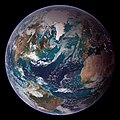Datei:Blue Marble Western Hemisphere.jpg

Größe dieser Vorschau: 600 × 600 Pixel. Weitere Auflösungen: 240 × 240 Pixel | 480 × 480 Pixel | 768 × 768 Pixel | 1.024 × 1.024 Pixel | 2.048 × 2.048 Pixel | 3.718 × 3.718 Pixel.
Originaldatei (3.718 × 3.718 Pixel, Dateigröße: 2,65 MB, MIME-Typ: image/jpeg)
Dateiversionen
Klicke auf einen Zeitpunkt, um diese Version zu laden.
| Version vom | Vorschaubild | Maße | Benutzer | Kommentar | |
|---|---|---|---|---|---|
| aktuell | 13:59, 5. Mär. 2013 |  | 3.718 × 3.718 (2,65 MB) | Szczureq | User created page with UploadWizard |
Dateiverwendung
Keine Seiten verwenden diese Datei.
Globale Dateiverwendung
Die nachfolgenden anderen Wikis verwenden diese Datei:
- Verwendung auf alt.wikipedia.org
- Verwendung auf av.wikipedia.org
- Verwendung auf bn.wikipedia.org
- Verwendung auf ca.wikipedia.org
- Verwendung auf ckb.wikipedia.org
- Verwendung auf cv.wikipedia.org
- Verwendung auf da.wikipedia.org
- Verwendung auf el.wikipedia.org
- Verwendung auf en.wikipedia.org
- Ecological footprint
- User:P3Y229/sandbox
- Wikipedia:Meetup/NYC/AfroCrowd/Home
- Wikipedia:Wikipedia Signpost/2018-10-28/Gallery
- Wikipedia:Wikipedia Signpost/Single/2018-10-28
- User:Lngnbchr/TWA/Earth/2
- User:Saoirse mck/TWA/Earth/2
- User:Northamerica1000/Topics
- User:Nikola Tesla edit/TWA/Earth/2
- User:SDL87/TWA/Earth/2
- User:Mpurcell1/TWA/Earth/2
- User:Mpbrooke/TWA/Earth/2
- User:Tlonedyr
- User:JD Cornbread/TWA/Earth/2
- Verwendung auf en.wikibooks.org
- Verwendung auf en.wikiquote.org
- Verwendung auf en.wiktionary.org
- Verwendung auf es.wikipedia.org
- Verwendung auf eu.wikipedia.org
- Verwendung auf fa.wikipedia.org
- Verwendung auf fi.wikipedia.org
- Verwendung auf fr.wikipedia.org
- Verwendung auf he.wikipedia.org
- Verwendung auf hu.wikipedia.org
- Verwendung auf hy.wikipedia.org
- Verwendung auf id.wikipedia.org
- Verwendung auf it.wiktionary.org
- Verwendung auf ja.wikipedia.org
- Verwendung auf kk.wikipedia.org
- Verwendung auf ko.wikipedia.org
Weitere globale Verwendungen dieser Datei anschauen.



